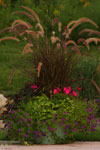|
Perenial Gardens
 Perennials is a term that describes what many gardeners and homeowners strive for, which is a plant that comes back every spring.
There are perennial plants that can meet just about every need a landscape has. Perennials range from low growing plants to tall growing
plants, from those that produce colorful flowers to those that provide visual pleasure with glowing seed heads, such as those exhibited by
some ornamental grasses. Perennial gardens need to be planted only once. The perennial garden can contain plants that flower, plants with
colorful leaves and foliage, and low growing ground covers for that especially shady spot.
Perennials tend to die back to the ground each winter. Perennial plants generally have fewer major problems than annuals and are sustainable
with lower care and maintenance needs. Blooming perennials tend to average about 3 weeks of bloom time so choosing plants with attractive
structure and foliage and flowers will enhance your landscape for years to come
Several additional advantages of growing perennial flower gardens are outlined here.
Perennials is a term that describes what many gardeners and homeowners strive for, which is a plant that comes back every spring.
There are perennial plants that can meet just about every need a landscape has. Perennials range from low growing plants to tall growing
plants, from those that produce colorful flowers to those that provide visual pleasure with glowing seed heads, such as those exhibited by
some ornamental grasses. Perennial gardens need to be planted only once. The perennial garden can contain plants that flower, plants with
colorful leaves and foliage, and low growing ground covers for that especially shady spot.
Perennials tend to die back to the ground each winter. Perennial plants generally have fewer major problems than annuals and are sustainable
with lower care and maintenance needs. Blooming perennials tend to average about 3 weeks of bloom time so choosing plants with attractive
structure and foliage and flowers will enhance your landscape for years to come
Several additional advantages of growing perennial flower gardens are outlined here.
- Growing perennial gardens is a better investment overall.
- Perennial flowers are versatile and add interest and color to gardens.
- Some perennials in the herbaceous family need to have their root systems divided every few years and this give you more plants without
buying new ones.
- Perennials and annuals can grow side-by-side which makes for a very colorful garden.
- Perennials have a variety of different foliages when not blooming, so perennial flower gardens don’t look bare in winter months.
Perennial flowers are used for many different landscape purposes such as borders, boundaries, ground covers, in containers, on trellises,
arbors, or pergolas. Keep these advantages in mind when planning a perennial flower garden.
Tips for Growing a Gorgeous Perennial Flower Garden
Site and Soil Considerations
Perennials are left in the same soil for many years select and prepare garden site with care. Perennial flowers also thrive planted in
raised flowerbeds. If your soil is poor, amend it with a mixture of compost, peat moss, or other organic matter. Perennials need well-drained
soil; if soil is too sandy, add small pea gravel to soil. Spade flowerbed to a depth of 8 to 10 inches, working in the soil amendments thoroughly.
Do this well ahead of planting time.
Perennial Flower Plant Selection
Determine your Plant Hardiness Zone prior to selecting your perennial flowers or shrubs. Although most perennials are hardy, there are some
that won’t thrive in certain climates. Some perennial flowers prefer sunny locations; others love the shade, so select your perennial flowers
according to where you will plant them.
|
Anual Gardens
 No other group of flowering plants provides as much color as quickly and economically as annuals. Annual plants sprout from seed, flower, set
seed, and die within one season. Many flowers, vegetables, and herbs are planted every year as annuals. Other plants may live longer in their
native lands, but do not survive the heat or cold of the mid-south and are best treated as annuals.
No other group of flowering plants provides as much color as quickly and economically as annuals. Annual plants sprout from seed, flower, set
seed, and die within one season. Many flowers, vegetables, and herbs are planted every year as annuals. Other plants may live longer in their
native lands, but do not survive the heat or cold of the mid-south and are best treated as annuals.
Annuals are inexpensive, especially when grown from seed. However, they do require soil preparation, fertilization, irrigation, weeding, and
pest control. Most are native to semiarid regions of the world and require full sunshine to survive.
Most annuals are planted in spring and are killed by frost in the fall. However, some, including pansies, ornamental cabbage, and dill are
tolerant of our winters and are best planted in the fall for color throughout the winter. These are usually killed by the heat of early summer.
Annual gardens are easily established in the smallest and most restrictive of spaces as well as the harsh conditions of a large suburban garden.
Their relatively shallow root systems require only a modest amount of soil. Gardeners with sizable yards quickly learn the trick of planting one
or two easy-to-grow beds of massed annuals to decorate patios, walks, or pools. Apartment dwellers can achieve a splash of color with a few well-placed
pots, wash tubs, or planter boxes of annuals.
Annuals that need full sun, such as periwinkle and marigold, grow and flower best when they receive at least 4 to 6 hours of direct sunlight each day.
Woodland species perform best under partial to heavy shade.
|
|
Visit our "Gardens" photo gallery to view a sample of our recent garden projects.
|